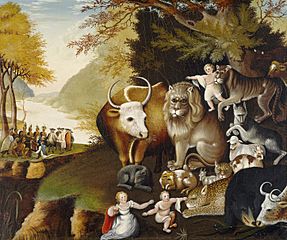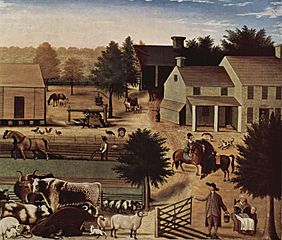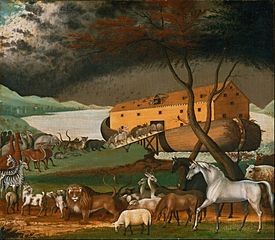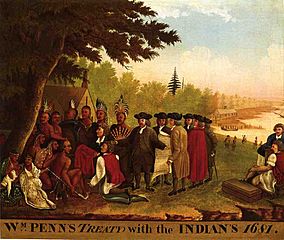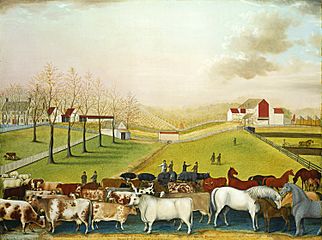Edward Hicks facts for kids
Quick facts for kids
Edward Hicks
|
|
|---|---|
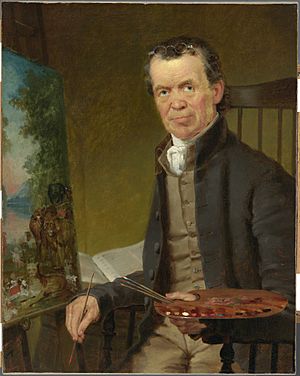
Edward Hicks Painting the Peaceable Kingdom by Thomas Hicks, 1839
|
|
| Born | April 4, 1780 Attleboro, Pennsylvania, U.S.
|
| Died | August 23, 1849 (aged 69) Newtown, Pennsylvania, U.S.
|
| Nationality | American |
Edward Hicks (born April 4, 1780 – died August 23, 1849) was a famous American folk painter. He was also an important religious minister for the Society of Friends, also known as "Quakers." He became well-known among Quakers partly because of his unique paintings.
Contents
Edward Hicks: Life and Art
Early Life and Quaker Faith
Edward Hicks was born in a large house in Attleboro, Pennsylvania. This town is now called Langhorne. His parents were Anglican, but his father, Isaac Hicks, lost all his money after the Revolutionary War.
When Edward was only 18 months old, his mother passed away. A close family friend, Elizabeth Twining, raised him on her farm. She taught him about the Quaker faith, which became very important to him throughout his life.
At age 13, Edward started learning to be a coach painter. He spent seven years with William and Henry Tomlinson, learning how to paint coaches. In 1800, he started working for himself as a painter of houses and coaches. He moved to Milford in 1801 to work for another coach maker.
Edward later wrote that he was a "wayward young man" who loved singing, dancing, and having fun. But he wasn't happy with his life. He began going to Quaker meetings regularly. In 1803, he officially joined the Society of Friends. Later that year, he married Sarah Worstall, a Quaker woman.
Working as a Minister and Artist
In 1812, Edward became a recognized Quaker minister. By 1813, he started traveling around Philadelphia to preach. To pay for his travels and support his growing family, Hicks expanded his painting business. He painted household items, farm tools, and even signs for taverns.
His painting business made good money, but some Quakers were concerned. They believed in simple living, and his decorative painting seemed too fancy. In 1815, Hicks tried to stop decorative painting and support his family by farming. He also continued with simple, useful painting that Quakers approved of. However, farming was difficult, and he didn't make enough money.
By 1816, his wife was expecting their fifth child. A relative and a close friend encouraged Hicks to return to decorative painting. This advice helped him avoid financial trouble. It also allowed him to continue his life as a Quaker artist, not just a minister. Around 1820, Hicks painted his first version of The Peaceable Kingdom. He often painted for family and friends, not usually for sale. Decorative painting remained his main way to earn money.
In 1827, the Religious Society of Friends split into two groups: Hicksites (named after Edward's cousin, Elias Hicks) and Orthodox Friends. This division saddened Edward Hicks, and he preached less often. Even so, during his lifetime, he was more famous as a minister than as a painter. He is buried at the Newtown Friends Meetinghouse Cemetery in Newtown Township, Pennsylvania.
Edward Hicks' Unique Paintings
Quaker beliefs encouraged a simple life, without too many fancy things. Edward Hicks found it hard to be both a preacher and a painter at the same time. He decided to focus on painting. He used his canvases to share his beliefs. Through his art, he could freely express his ideas about faith, which sometimes religion alone couldn't fully show.
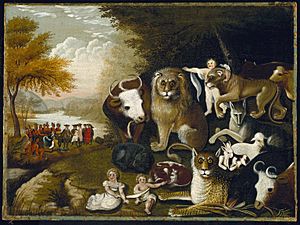
Hicks' most famous work is The Peaceable Kingdom. Even though it's not a traditional religious image, it shows Quaker ideas. He painted 62 different versions of this scene! The animals and children in the painting come from a Bible verse (Isaiah 11:6–8). This verse describes a lion eating straw with an ox, showing a peaceful world. Hicks used his paintings to explore his main interest: finding a good and pure soul. This was a key part of his religious beliefs.
Hicks' art was also shaped by a Quaker idea called the 'Inner Light'. Early Quakers, like George Fox, taught that people could find salvation by listening to the "Christ within" them. This idea comes from the Bible (Colossians 1:27). Hicks showed humans and animals living together peacefully. This represented the Inner Light's idea of breaking down differences to work and live in harmony. Many of his paintings also show Native Americans meeting the settlers of Pennsylvania, with William Penn often featured.
Hicks admired William Penn because Penn stood up against British power in America. Penn also made a famous treaty with the Native Americans in Pennsylvania. This treaty helped the Quaker community grow strong there.
Exhibitions and Painting Style
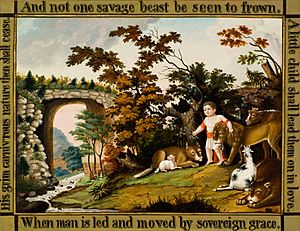
Edward Hicks' first big art show was in 1860 in Williamsburg, Virginia. Some people liked his work, but others found it repetitive because he painted similar scenes many times. His earliest known painting was shown in 1826. Kingdoms of the Branch was displayed at the Philadelphia Museum of Art. Hicks used Penn and the Native Americans in his art to illustrate the Bible's prophecy from Isaiah.
His paintings often focused on religious themes but used everyday events to show them. Hicks used symbols to share his message. For example, he painted predators like lions next to prey like lambs. This showed his theme of peace. Peaceable Kingdoms of the Branch (1826–30) is a great example of his lasting work. It is now at the Reynolda House Museum of American Art.
The Newtown Historic Association has a special collection of information about Edward Hicks.
How Hicks Painted
Hicks' paintings often look similar to each other. For example, his 1834 Peaceable Kingdom and 1845 The Residence of David Twining have many things in common. In both paintings, the right side often looks the busiest. The size of objects seems to show how important they are, not how far away they are. Both paintings show people and animals together, creating a feeling of community. For instance, in Peaceable Kingdom, settlers are in the background signing a treaty with Native Americans.
Hicks' paintings usually show calmness and peace, not sudden action. Many shapes in his art are soft and flowing. You need to look closely at the gestures of people and animals to understand the meaning. Hicks used small, deliberate changes in detail to make viewers pay close attention.
While no two of his paintings are exactly alike, Hicks followed certain patterns. The space in his paintings might seem flat, but he created depth using the size of objects and, less often, light and shadows. The front, middle, and back of his paintings are filled with objects, animals, landscapes, people, and skies.
Hicks almost always painted outdoor scenes, with light coming from the sun or sky. The colors in his work are usually simple. In paintings like Peaceable Kingdom, many colors have a similar warm or brown tone. This was another way Hicks tried to show "uniformity" or peace. Most of his paintings are balanced in an uneven way, which helps show the actions happening between groups of people and animals.
Gallery of Major Works
-
The Residence of David Twining, (1845–1848), Abby Aldrich Rockefeller Folk Art Collection
-
The Cornell Farm (1848), National Gallery of Art
Selected Works and Their Locations
- The Residence of David Twining 1785, 1846, American Folk Art Museum, New York City
- The Peaceable Kingdom, c. 1833, Worcester Art Museum, Worcester, Massachusetts
- The Falls of Niagara, c. 1825, and The Peaceable Kingdom, c. 1830–32, Metropolitan Museum of Art, New York City
- Penn's Treaty With the Indians, c. 1830–40, Museum of Fine Arts, Houston, Texas
- Noah's Ark, 1846 and The Peaceable Kingdom, c. 1844–46, Philadelphia Museum of Art, Philadelphia
- Grave of William Penn, 1847, Newark Museum, Newark, New Jersey
- The Cornell Farm, 1848; The Grave of William Penn, c. 1847–48; The Landing of Columbus, c. 1837; The Peaceable Kingdom, c. 1834; Penn's Treaty With the Indians, c. 1840–1l44; and Portrait of a Child, c. 1840, National Gallery of Art, Washington, DC
- The Peaceable Kingdom, 1830–32, Montgomery Museum of Fine Arts, Montgomery, Alabama
- Peaceable Kingdom of the Branch, c. 1826–30, Reynolda House Museum of American Art, Winston-Salem, North Carolina
See also
 In Spanish: Edward Hicks para niños
In Spanish: Edward Hicks para niños





